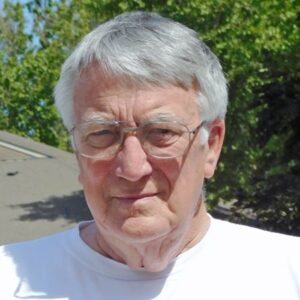
Home » Museum to unveil permanent Day’s Pay display
‘Give a day’s pay and send a bomber on its way’
Museum to unveil permanent Day’s Pay display

Day’s Pay is the B-17 bomber built from one day’s wages contributed by 44,300 Hanford employees.
Courtesy East Benton County Historical SocietyOctober 1, 2024
Employees at the top-secret Hanford Engineer Works in World War II were clueless to the contribution they were making to bring the war to a successful conclusion through their history-making efforts on the project.
Those efforts resulted in the production of plutonium to arm a second atomic bomb. When it was dropped on Nagasaki, Japan, on Aug. 9, 1945, a swift end came to World War II.
The Nagasaki bomb came three days after a uranium-armed atomic bomb was detonated over the Japanese city of Hiroshima on Aug. 6, 1945.
Japan’s Emperor Hirohito announced surrender in their aftermath.
But months before, some 44,300 workers at the Hanford site were seeing the fruits of another contribution they made to the war effort to defeat the Axis powers of Germany, Japan and Italy.
It came in the form of frequent reports on how “their” B-17 Flying Fortress was doing on bombing missions targeting the war machine of Nazi Germany.
Day’s Pay, the B-17 bomber built from one day’s wages contributed by those 44,300 Hanford employees, had been flying combat missions since its European arrival in the summer of 1944.
It flew into combat following dedication ceremonies at Hanford 80 years ago this summer.
A promise was made at that ceremony to Hanford employees that they would be kept abreast of action by their plane.
Day’s Pay would fly 60 or so missions over Germany, Belgium and France raining destruction on German targets. Ship assembly bases, U-boat pens, bearing plants, Nazi-controlled oil fields, and other manufacturing took a pummeling from Day’s Pay.
Hanford workers learned Day’s Pay had taken hits from enemy ground fire to the nose, engine and gas tank, but had returned from each of its missions.
Hanford historian Donald Sorenson will speak on the history of Day’s Pay on Nov. 9 at the East Benton County Historical Society Museum at Keewaydin at 205 Keewaydin Drive in Kennewick.
His address is part of dedication ceremonies for a permanent Day’s Pay display at the museum across the street from the east end of Keewaydin Park.
It is to be at 2 p.m. on the Saturday of Veterans Day weekend.
The event is free to the public. Veterans are to be admitted free to the museum throughout November.
The display is to feature a model of the Day’s Pay B-17 bomber assembled by Michael Aldrich of West Richland mounted on a wood display case protected by a glass covering.
At Hanford, Day’s Pay came out of a suggestion by one employee after he received a letter in 1944 from a son fighting in Europe. His son praised the aerial support ground troops were receiving, and his father suggested to his Hanford work crew that employees should donate one day’s pay to buy an American bomber.
The idea spread like wildfire.
A Give a Bomber Committee was formed and a slogan soon derived: “Give a day’s pay and send a bomber on its way.”
Employees raised $300,000.
Naming Day’s Pay resulted from a contest among employees. Ten different workers suggested the name as most suitable. Two were carpenters, two came from transportation, joined by a water and sanitation worker, a patrolman, one from information services and another from investigation services, a mechanic and one from payroll.
A special certificate was awarded all those who contributed “acknowledging their share of the bomber.”
Formal christening ceremonies on July 23, 1944, included a Gold Star mother, Katie Belle Harris, breaking a champagne bottle over the nose of the B-17. Her son had been killed in action earlier in 1944. Day’s Pay was painted on the nose just above wording explaining the plane’s origin: “Presented to the Army Air Forces as a Result of Cash Contributions by Employees of Hanford Engineer Works.”
Further explaining its origins was a plaque mounted in the bomber.
In Europe, Day’s Pay was assigned to squadrons and bomb groups of the 8th Air Force for its combat missions.
In January 1945, Hanford workers learned that the plane had completed its 50th mission. A message had been sent to them from the pilot of Day’s Pay, Lt. Arlys Wineinger and the crew, reading: "DAY’S PAY has seen us through our operational tour. Our appreciation and thanks to each and every one of you.”
It would fly 10 more combat missions.
When the war ended in Europe, Day’s Pay was flown back to the United States in July 1945.
In October 1945, thousands of planes were declared “excess,” with Day’s Pay was among them, and they were disassembled. Hanford employees were informed of the action.
The heritage of Day’s Pay remains strong to this day. The Richland Police Department in 2023 redesigned its badge and its uniform patch to incorporate local landmarks and Day’s Pay is prominent on them.
Gale Metcalf of Kennewick is a lifelong Tri-Citian, retired Tri-City Herald employee and volunteer for the East Benton County Historical Museum. He writes the monthly history column.
Senior Times
KEYWORDS October 2024
Related Articles
Related Products




